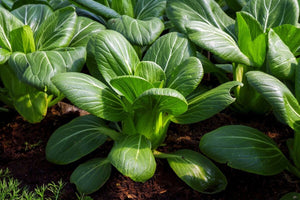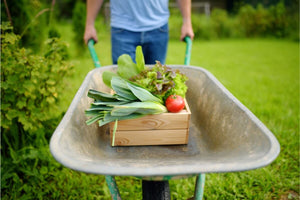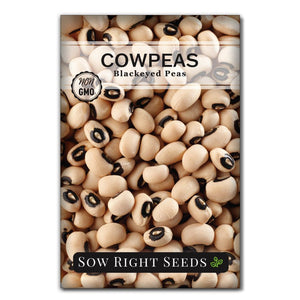Sweet After Frost: How to Grow Collard Greens in Cool Climates
Collard greens are a classic in Southern gardens. They have hearty leaves that are prized for their flavor in stews and slow-simmering soul food. But this traditional vegetable isn’t just for warm climates. Collards also thrive in cooler climates. They are cold-tolerant and get sweeter when temperatures drop. Learn how to grow collards from seed, no matter your climate.

How to Grow Collard Greens from Seed
Growing collard greens is very similar to growing all the rest of your leafy green vegetables. The seeds can be direct sown or started indoors and then transplanted into the ground or containers.
Even though collard greens have a deep tradition in the South, they’re an excellent crop for growing throughout the United States.
If you’ve never grown them before or seen what they look like before they are cooked, they remind me of cabbage leaves. Although a member of the Brassica family, collards are a loose-leafed plant, similar to kale. If I didn’t have them labeled, it would be easy to confuse collard greens with cabbage plants that never formed a head.
There are many varieties of heirloom collards. The different varieties have developed over time, and some grow better in specific locations than others. There are also personal preferences that gardeners have.
Vates collards are a well-known heirloom variety. They are heat-resistant and cold-hardy. Vates works well in small home gardens. You can expect to start harvesting leaves around 60 days after planting.
Georgia Southern Collards are an heirloom variety that has been grown since the 1880s. They are heat-resistant and cold-hardy to 20ºF. The frost makes them taste even better.

Tips for fail-proof collard seed germination
Start seeds 4 to 6 weeks before transplanting
Plant seeds ½” deep
Keep soil moist until seeds germinate in 10 to 21 days
Soil temperature should be 50-70ºF
Collard green seedlings can be transplanted outside when temperatures are around 60ºF. Take time to harden off the seedlings before transplanting to avoid transplant shock. Even though they are cold-tolerant, they need to transition from the relative comfort of indoors to the harsher outdoor conditions.
Space collard plants 12 to 24” apart.
Collard seeds can also be direct sown 6 weeks before the first frost in the fall. When direct sowing seeds, the soil temperature will affect the germination rate. Although the seeds can germinate in soil that is 40ºF, a slightly warmer temperature range of 50-70ºF will result in faster and improved germination.
Collard greens are easy to grow from seed and thrive in both warm and cool climates. Sow seeds directly in the garden or start them indoors 4–6 weeks before your last expected frost date. Collards grow best in full sun and rich, well-drained soil. Regular watering and light feeding will produce tender, flavorful leaves that actually get sweeter after frost, making them one of the most dependable leafy greens for any home garden.

How to Grow Collard Greens
Sun
Collards will grow well in full sun to partial shade. They need a minimum of 4 hours of direct sunlight daily. However, in cooler climates, you want to make sure they get 6 to 8 hours of sunlight.
Soil
Grow collards in rich, fertile soil with a pH between 6.0 and 7. Amend the soil with compost or aged manure before planting. The soil can be a heavy loam, but it needs to drain well to prevent root rot.
Water
Keep collard plants well watered. The soil should remain consistently moist. In the summer, heat stress can cause plants to bolt, so add mulch to help retain moisture and keep the soil cool.
Fertilizing
Start with nutrient-rich soil and then add compost tea or a nitrogen-rich fertilizer every 3 or 4 weeks. While most vegetables don’t require extra nitrogen, leafy greens like collards will thrive with this important nutrient for leaf growth.
Growing Collard Greens in Containers
Collards can be grown in raised beds and containers. The containers will need to be at least 12” deep for roots to grow. Also, make sure the container can drain well to keep the soil moist without becoming waterlogged.

Solutions for Pests and Diseases
Pests that typically damage brassicas will also affect collards. Aphids, cabbage worms, and cabbage loppers are some of the common pests.
A layer of defense is the first thing to protect your harvest. Use row covers to keep moths from laying eggs.
Once you spot worms, you can handpick them off or use BT spray to keep your collards from being damaged by those hungry caterpillars.
Harvesting Collard Greens
Collard greens start maturing around 60 days from planting. However, you can start harvesting young leaves anytime when they are at least 5 inches long.
That’s one of the perks of growing your own greens. You can decide when they’re the perfect size.
You can harvest the leaves individually and leave the core to keep growing. Cut off leaves with scissors or a knife.
Collard greens are sturdy leaves that are usually cooked for an extended period of time to make them more tender. The hard middle is usually cut out.
Of course, the younger, smaller leaves are more tender, but the reality is that you’ll quickly get monster-sized leaves. Don’t worry. These will also cook down into tasty greens.
Simmer long and slow on low heat, preferably with a hambone or bacon for a savory flavor.
An easy way to eat fresh collard greens is to add them to a green smoothie. Include an apple to sweeten the mix.
Collard Green FAQs
Can collard seeds be direct sown?
Collard greens can be started from seed indoors or direct sown. When starting seeds indoors, use grow lights to prevent seedlings from becoming leggy.
How long do collards take to grow?
Collards reach maturity in about 60–80 days from seed, but you can begin harvesting baby leaves much sooner.
Can collard greens survive frost?
Yes! Collards are extremely cold-hardy and can tolerate temperatures as low as 20°F. In fact, their flavor improves after exposure to frost.
Do collard greens regrow after cutting?
Yes, as long as you harvest outer leaves and leave the growing center intact, the plant will keep producing for weeks or months.

Compelling Reasons Gardeners Should Grow Collard Greens
1. Cold-Tolerant and Sweetens with Frost
Collards are one of the most cold-hardy greens you can grow. While many vegetables fade with the first frost, collards actually get sweeter as the temperatures drop. The light frost converts starches into sugars, creating tender, flavorful leaves even late into fall or early winter.
2. Long Growing Season and Flexible Harvest Window
Northern gardeners can sow collards early in spring for a fast-growing leafy crop, and again in late summer for a reliable fall harvest. Even after most crops have been pulled, collards can keep producing until deep winter in many regions with minimal protection.
3. Low-Maintenance and Pest-Resistant
Compared to spinach or kale, collards are remarkably tough and forgiving. They tolerate poor soils, uneven watering, and even partial shade. They’re also less prone to bolting in unpredictable northern spring weather.
4. Productive and Easy to Harvest
Collard plants are generous producers. You can harvest outer leaves as needed, and the plant keeps growing from the center. This “cut-and-come-again” style means one planting can feed you for months.
5. Nutritious Super Green
Collards are loaded with vitamins A, C, and K, along with calcium, fiber, and antioxidants. They provide hearty, nutrient-dense greens that can serve as a substitute for kale or Swiss chard.
6. Perfect for Extending the Garden Season
In cooler climates, collards can bridge the gap between warm-season crops and winter. They’re ideal for succession planting, cold frames, or overwintering experiments — great for gardeners who like to push the season.
7. Unique Flavor and Culinary Versatility
Collards have a mild, rich flavor that is less bitter than kale and more substantial than spinach. They’re delicious sautéed, added to soups, or even eaten raw in salads when young.
Collard greens are easy to grow and are so healthy for you, which is why they’ve been a staple in home gardens for generations. They thrive in both warm and cool weather, producing nutritious greens long after other vegetables have faded.
Maybe it's time to add collard greens to your garden. Try these heirloom varieties from Sow Right Seeds for seeds that are guaranteed to grow.
Popular Posts
-

How to Plant and Harvest Quick-Growing Bok Choy (Pak Choi)
-

Top 15 Vegetables to Grow for Food Pantry Donations







Leave a comment